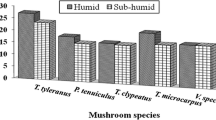Abstract
Thirty-seven wild plants as food for Asian elephants in the field in Simao, Yunnan province, China and five cultivated plants as food for captive elephants in the Beijing Zoo were collected and analyzed for their main nutrient components. Protein, fat, fiber, dry material, ash as well as major microelements: calcium, kalium, zincum, sodium in the food were analyzed by standard methodology. No significant differences were found between the wild plants taken in the field and forage provided in captivity. However, the calcium content in the forage is significantly less than the average of those in the wild plants. It is suggested that the increase in calcium intake may contribute to the relief of low plasma calcium diseases of elephants in captivity.
Similar content being viewed by others
References
Dougall H W (1964). The chemical composition of a day’s diet of an elephant. East African Wildlife Journal, 2: 51–59
Eisenberg J F (1981). The Mammalian Radiations: An Analysis of Trends on Evolution, Adaptation and Behavior. Chicago: University of Chicago Press
Gu J H (1990). Feed Analysis. Beijing: Science Books and Periodicals Press, 6–10 (in Chinese)
Hanks J (1979). A Struggle for Survival: The Elephant Problem. London: Country Life Books
Kloes H G, Lang E M (1982). Handbook of Zoo Medicine. New York: Van Nostrand Reinhold Company
Macdonald D (1984). The Encyclopedia of Mammals. London: Andromeda
McKay G M (1973). Behavior and ecology of the Asiatic elephant in southeastern Ceylon. Smithsonian Contributions to Zoology, 125: 1–113
Nowak R M (1995). Walker’s Mammals of the World London. Baltimore: The John Hopkins University Press
Santiapillai C, Jackson P (1990). The Asian elephant action plan for its conservation. Gland: IUCN/SSC Asian Elephants Specialist Group, 1–80
Shoshani J, Eisenberg J F (1982). Elephas maximus. Mammalian Species, 182: 1–8
Sukumar R, Ramesh R (1995). Elephant foraging: is browse or grass more important? In: A Week with Elephants: Proceedings of the International Seminar on the Conservation of Asian Elephants. Oxford: Oxford University Press, 368–374
Wang S (1998). China Red Data Book of Endangered Animals. Beijing: Science Press, 211–214 (in Chinese)
Yang S (1993). Techniques of Analysis and Quality Determination of Feedstuff. Beijing: Beijing Agriculture University Press, 16–28 (in Chinese)
Zhang L, Wang N (2003). An initial study on habitat conversation of Asian Elephant conflict in Simao, China. Biological Conservation, 112: 453–459
Zhang L, Wang N, Wang Y N (2003). A preliminary study on the habitat and behaviors of Asian
Elephant (Elephas Maximus) in Simao, Yunnan, China. Acta Theriologica Sinica, 8(23): 85–192 (in Chinese)
Author information
Authors and Affiliations
Corresponding author
Additional information
Translated from Journal of Beijing Normal University (Natural Science), 2006, 42(2): 184–188 [译自: 北京师范大学学报 (自然科学版)]
Rights and permissions
About this article
Cite this article
Lihong, W., Liu, L., Qian, H. et al. Analysis of nutrient components of food for Asian elephants in the wild and in captivity. Front. Biol. China 2, 351–355 (2007). https://doi.org/10.1007/s11515-007-0052-0
Issue Date:
DOI: https://doi.org/10.1007/s11515-007-0052-0




